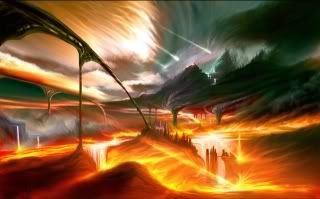Life certainly seems stranger than fiction: the real story of Dracula makes Bram Stoker's vampire seem quite tame!
He has been known by many names: Vlad Tepes and Vlad the Impaler. Admired by many in Romania as a hero; feared by his enemies as a butcher. The truth is far more bizarre than anything Bela Lugosi, Gary Oldman, Francis Ford Coppola or Hollywood could have imagined.
Here's the real story of Dracula and the turbulent area of Eastern Europe that was his home. Follow the text links for more information about the man himself.
Historical backgroundDracula's grandfather, Prince Mircea, reigned over Wallachia from 1386-1418. Wallachia, together with Transylvania, form the area now covered by Romania. This area was threatened by invasion from the Ottoman Turks and Prince Mircea fought to keep the country's independence from the Turks. Unfortunately, this meant that he had to pay 'tribute' to them: a kind of bribe to keep the Turks off Wallachian soil.
At this time, princes were elected by wealthy landowners (the Boyars) and this inevitably led to quarrels and disagreements. Eventually, two groups (opposed to each other) emerged: Mircea's supporters and the Danesti clan.
Mircea's son (Dracula's father), Vlad, was born in 1390 and spent his youth growing up in the court of King Sigismund of Hungary. (The King later became the Holy Roman Emperor). Here, Vlad became a member of the Order of the Dragon: an elite group sworn to fight the Ottomans and uphold the Catholic faith (but with a secret subtext to strengthen the House of Luxemburg's political supremacy in Europe). Thus, Vlad became known as Dracul or Dragon (Dracula means son of the dragon). Dracul also means devil but it seems unlikely that contemporaries thought of Vlad in this way.
Eventually, Vlad became the Governor of Transylvania, living in Sighisoara where Dracula was eventually born. Vlad's ambitions, however, were not satisfied and he killed Prince Alexandru I and became Prince Vlad II
Like his father, Vlad had to pay tribute to the Turks who were the enemies of Hungary. As Vlad was also a vassal of Hungary, this caused problems, especially when the Turks invaded Transylvania in 1442. Vlad was desperate to stay neutral but this angered Hungary and they drove him out of Wallachia
Meanwhile, a Hungarian General, named Janos Hunyadi, made a Danesti, Basarab II, prince. All changed in 1443 when Vlad, with the Sultan's assistance, regained the throne!
In 1444, Vlad, together with his two youngest sons, travelled to Turkey at the request of the Sultan. However, the invitation was simply a pretext to hold them all hostage. Eventually, Vlad was released, but the sons, Dracula and Radu (known as Radu the Handsome), remained. The Turks held many hostages, mainly to keep their rivals in check, but also to influence young minds and make them more amenable to the Ottoman Empire.
Although the sons were treated fairly well (they received an excellent education), Dracula must have felt abandoned by his father and he was prone to fits of temper. Radu, on the other hand, seems to have developed a fondness for the Turks and remained with the Sultan.
When Hungary declared war on Turkey in 1444, Vlad sent his oldest son, Mircea, to fight rather than go himself and anger the Sultan. At the Battle of Varna, the Christians were beaten and Vlad and Mircea blamed Hunyadi for the defeat
Hunyadi may have been behind the deaths of Vlad and Mircea in 1447 (although this has not been proven). Mircea's death was particularly horrible: buried alive by the Boyars of Tirgoviste.
A Danesti (Vladislav II) was placed on the throne and the Turks (not wanting a Hungarian puppet on the throne) freed Dracula and gave him an army (Radu remained in Turkey, a loyal subject of the Sultan). Dracula seized the throne but only held it for two months before being forced into exile in Moldavia. Vladislav II became prince!
Three years later, the status quo changed when Vladislav II began supporting the Turks. Dracula became Hunyadi's vassal and in 1456 killed Vladislav II and gained the throne (again!).
Near the EndIn 1462, Dracula attacked the Turks but was driven back by a much larger army. When the Sultan arrived at Tirgoviste, it was said that 20,000 Turks were found impaled outside of the city. This has become known as the 'Forest of the Impaled'. When the Sultan's officers saw this horrific site, they refused to carry on! (The real story of Dracula shows a ruthless, sadistic man, capable of unspeakable cruelty, often in the name of entertainment!).
However, Radu (part of the invading force), refused to retreat and forced Dracula to retreat to Poenari. Here, Dracula escaped through a secret tunnel, but not before his terrified wife had thrown herself off the battlements.
Dracula went to Matthias Corvinus (the new King of Hungary) for assistance, but was thrown into jail!. Radu became the Prince of Wallachia (although under the control of the Turks) and Dracula tried to please the Hungarians by becoming a Catholic and marrying one of the King's family.
The EndRadu died in 1475 and in 1476, Dracula invaded Wallachia and, once again, became Prince.
This was a brief return to power as the Turks soon attacked and killed Dracula near Bucharest in 1476. There seem to be many accounts of how he died: a Turkish assassin disguised as a servant, or perhaps killed by his own army when he disguised himself as a Turk to confuse the enemy. Whatever, the real manner of Dracula's death, his head was soon being parading on a pike around the streets of Constantinople (the Sultan wanted everybody to know that Dracula was dead!).
Dracula was buried at Snagov (an island monastery).
Postlude1931: excavations on Snagov find the tomb of Dracula, but there is no coffin to be found! The real story of Dracula continues to fascinate the world just as much as the fictional Count!
Source Links:http://en.wikipedia.org/wiki/Vlad_III_the_Impalerhttp://www.dracula-in-whitby.com/real-story-of-dracula.html




